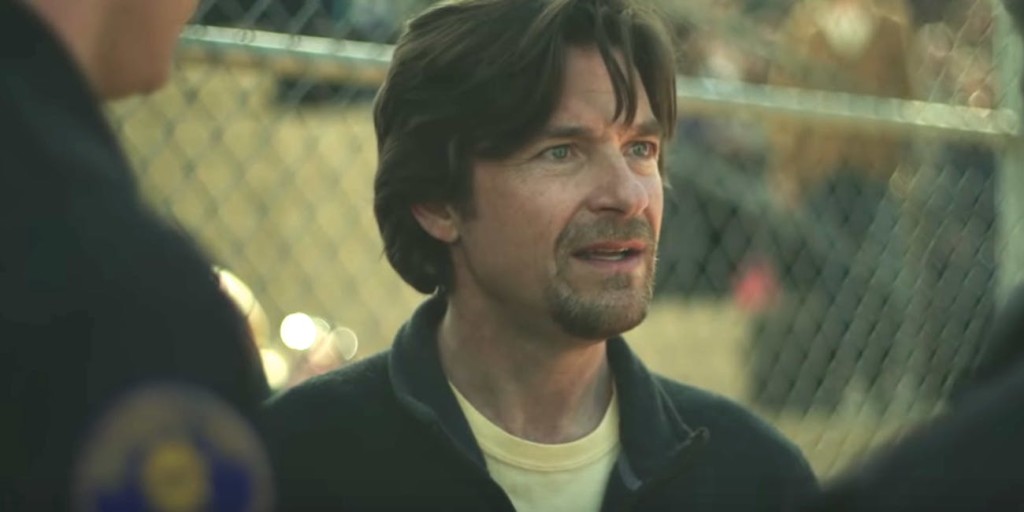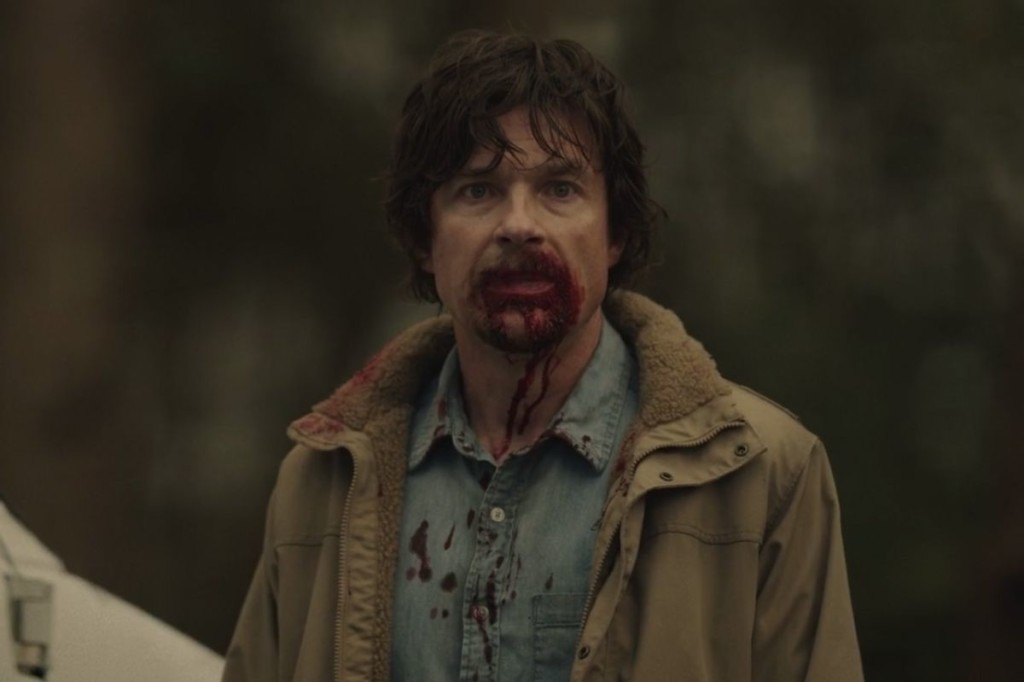Today I give you TWO new great screenwriting tips to add to your screenwriting tool shed. They’re called “upgrading” and “paralleling,” and The Outsider shows us how to pull them both off.
This weekend I decided to take a chance on The Outsider. Why do I phrase it like that? “Take a chance?” Because let’s be real. Another Stephen King adaptation? I saw It 2. I endured Pet Cemetery. They were awful. And The Outsider wasn’t exactly a worldbeater book. I remember it being advertised when it first came out, like all Stephen King novels, but after that, it drifted into the ether.
Imagine my surprise, then, when I sat down for the pilot of Outsider and within ten minutes I was hooked. And not just hooked. Hardcore “this is the greatest show ever” hooked. Okay, maybe not the greatest show ever. But anything that can make me forget about the hundred other things I have do in the moment is a darn good show.
And when you’re doing something that right, I have to figure out why. Because The Outsider has the most basic of basic hooks. A dead body. It’s a little more intense because it’s a child who’s been murdered. But it’s nothing we haven’t seen before if we’ve watched any cop or detective show ever. So why was this special? What did it do to rope me in? That’s what I want to find out.
SPOILERS BELOW!!!!!!
1) It doesn’t waste any time – There’s nothing that says you can’t use the beginning of your pilot to establish your characters. This is television. In the last decade, they transformed TV specifically into a character development medium. However, it’s 2020, the year of the shortest attention span ever. So while you can certainly slow-build your way through your pilot, you probably shouldn’t. It’s a better idea to get us into the story right away, like a movie. The very first scene of this show is the crime scene of the murdered boy. We waste NO TIME. But what about character development, Carson? Do we toss it in the garbage? No. You do something called PARALLELING. This is when you push both the story forward AND develop character at the same time. In this case, Detective Ralph Anderson comes onto the scene and you start peppering his arrival with insights into his character. Through the music he listens to, through the downbeat manner in which he interacts with others, we see that this man walks with 10,000 pounds of hard life strapped to his back. You’re not telling us as much as you could if you built a scene specifically to tell us about the character. But that’s the challenge. We have to get into the story so you need to find little moments here and there to reveal character. And it’s never as hard as you think. You just have to pay attention to it.
2) Upgrade your key scenes – I want you to imagine you’re writing a TV episode about a murder. Your detective has gathered enough evidence to arrest the alleged murderer. Where does this scene happen? Go into your head right now and imagine where does he arrest this man? I’m guessing that the first image that comes to mind is the alleged murderer’s house. Our detective shows up. The murderer’s wife is confused. What are the police doing here? They ask her if her husband is home. He is. They barge in. Arrest him. The wife starts screaming. The kids start crying. It’s a perfectly fine scene. It’s probably even memorable. Viewers are going to be impacted by it. There’s only one problem. WE’VE SEEN IT ALREADY. And when it comes to key scenes, “seen it already” is screenwriting death. For every key scene you have, you should be looking to UPGRADE! You want to think bigger. You want to think ‘more original.’ And that’s what they do in The Outsider. Detective Anderson, who has some mysterious personal vendetta against Terry Maitland, makes the decision to arrest him at the little league game that Terry’s coaching. He doesn’t just want to arrest Terry. He wants to humiliate him. He wants everybody in town to see it. And so we get this intense arrest scene with cops walking onto the baseball field and arresting Terry for the murder of the boy (something they make loud and clear). This scene works for a few reasons. There’s irony here. A children’s baseball game is supposed to be innocent and safe. Yet we’re arresting our co-protagonist for murder in the middle of it. But the biggest reason it works is because it’s an UPGRADE on the scene we usually see. Whenever you encounter a key scene in your script, you better be upgrading.
3) An authenticity to the proceedings – One of the things that drives me crazy in scripts is when something enormous happens but the characters don’t act as if something enormous happens. For example, I’ve seen bad cop shows where someone’s been murdered and, in the next scene, the detectives are cracking jokes. Or nobody seems upset about what happened. The issue is that the writer is unaware of the temperature in the room. For him, a death is not a tragedy. It’s a way to get his plot moving. And since he doesn’t treat the death as real, none of the characters do either. The Outsider is the opposite of that. It doesn’t just ask what our key characters feel about this tragedy. It asks what everybody in town feels. And so the murder isn’t just a plot-starter. It’s an honest look at what happens when there’s tragedy in a small town. For example, the mother of the murdered child ends up having a heart attack and dying because the murder of her child is too much. We find out Detective Anderson’s child died recently so this murder of a young child hits him on a deeper level. Too many writers write with plot-blinders on. They see every event as a means to move their plot along as opposed to sitting down and thinking about the effects of the events they’re writing about. I can’t emphasize this enough. It’s one of the main reasons I dismiss scripts these days. There’s zero authenticity in the proceedings (note: I realize there’s a sliding scale when it comes to authenticity and genre – a comedy doesn’t have to play by the same authenticity rules as a show like The Outsider. But like every genre, it needs some basis for authentic behavior).
4) Look for the uncommon in your common scenarios – I’m going to cheat here a little bit but one of the best scenes in this series comes in the second episode. In it, there’s a moment where Terry is being transported from the jail house to the courthouse. It’s a scene we’re familiar with. It’s where the suspect has to be walked up through a crowd of angry yelling people who want the murderer to know just how terrible a person he is. For this reason, I call this a “common scenario.” The great thing about common scenarios is that you can use the viewer’s expectation of the scenario against them. I’ve been breaking down scripts forever. And I fully expected this scene to go as planned. We’re going to see him get out of the car, the lights are blinding, the noise is off the charts. He walks towards the courthouse and people are calling him terrible things and reporters are yelling questions and they have to fight their way through a collapsing crowd in the last 15 feet and barely get inside to the safety of the building. But what happened instead? Halfway to the building, a man steps straight in front of the group, raises a gun, shoots the first two cops dead, starts shooting at Terry, and then Detective Anderson is able to kill him. I don’t remember being this shocked watching a scene in a long time. And it’s because the writer used our expectation of a common scenario against us. — By the way, I know some of you might think of this as an UPGRADE scene. But it isn’t. An upgrade scene is when you change the scene at the conceptual level, starting with the location. Here, keeping the location is actually what you’re looking for. You’re trying to lure the viewer into a false sense of security.
5) Don’t take drama off – Too many writers focus on the big dramatic beats in the story and, in the process, overlook opportunities to explore drama in smaller scenes. When Terry is sent to jail, it could’ve just been a shot of him behind bars looking sad. Instead, we watch Terry go through the humiliating process of being signed into the jail, and also being spotted by a large scary cell mate who recognizes him from TV as “that guy who killed that kid.” He tells Terry right then and there that he’s going to kill him. And the moment arrives where it’s Terry’s turn to enter the big cell where all the criminals are located, including that man. We know that if Terry goes in there, he’s dead. So he tells the C.O. “I can’t go in there.” The C.O. shrugs his shoulders like, “I don’t care.” And just when he’s about to walk the plank, another cop comes over, recognizes the danger of the situation, and puts Terry in a separate cell. It’s an intense moment and it’s a moment that average writers could easily miss. There’s drama everywhere in your story. You just have to keep your eyes open for it.
In addition to this, The Outsider has a clever mystery at its core. Terry Maitland’s DNA is all over the crime scene. There are four witnesses who saw him come out of the woods where the boy was found, his clothes drenched in fresh blood. However, Terry Maitland is also on video in another town at the exact time of the murder. I bring this last part up because I like shows that focus on immediate mysteries AND an overarching mystery because it gives us two things to get excited about. Sometimes writers will only focus on the present and there’s no overarching problem that needs to be resolved. I would advise against this. Something to keep in mind if you’re entering a pilot script into The Last Great Screenwriting Contest. :)



